Psychological Marketing: A Literature Review on Consumer Behavior
VerifiedAdded on 2020/06/05
|25
|9447
|51
Literature Review
AI Summary
This literature review delves into the application of psychology within the field of marketing, focusing on how companies employ various strategies to shape consumer perceptions and influence purchasing decisions. The review explores key concepts such as priming, including repetition and semantic priming, and their impact on consumer behavior. It highlights how marketers leverage psychological tactics, often unconsciously, to create positive associations with products and services, ultimately driving sales and profitability. The review examines the importance of understanding consumer expectations, the role of emotional appeals, and the ethical considerations of psychological marketing, providing insights into how businesses can effectively engage with their target audiences and build lasting brand loyalty. The literature review covers the impact of priming on consumer behavior, detailing how both positive and negative priming affect the speed of processing and influence decision-making processes. The document emphasizes the strategies employed by marketers to influence customers without their conscious awareness, and highlights the significance of adapting marketing approaches to meet the diverse needs of consumers.
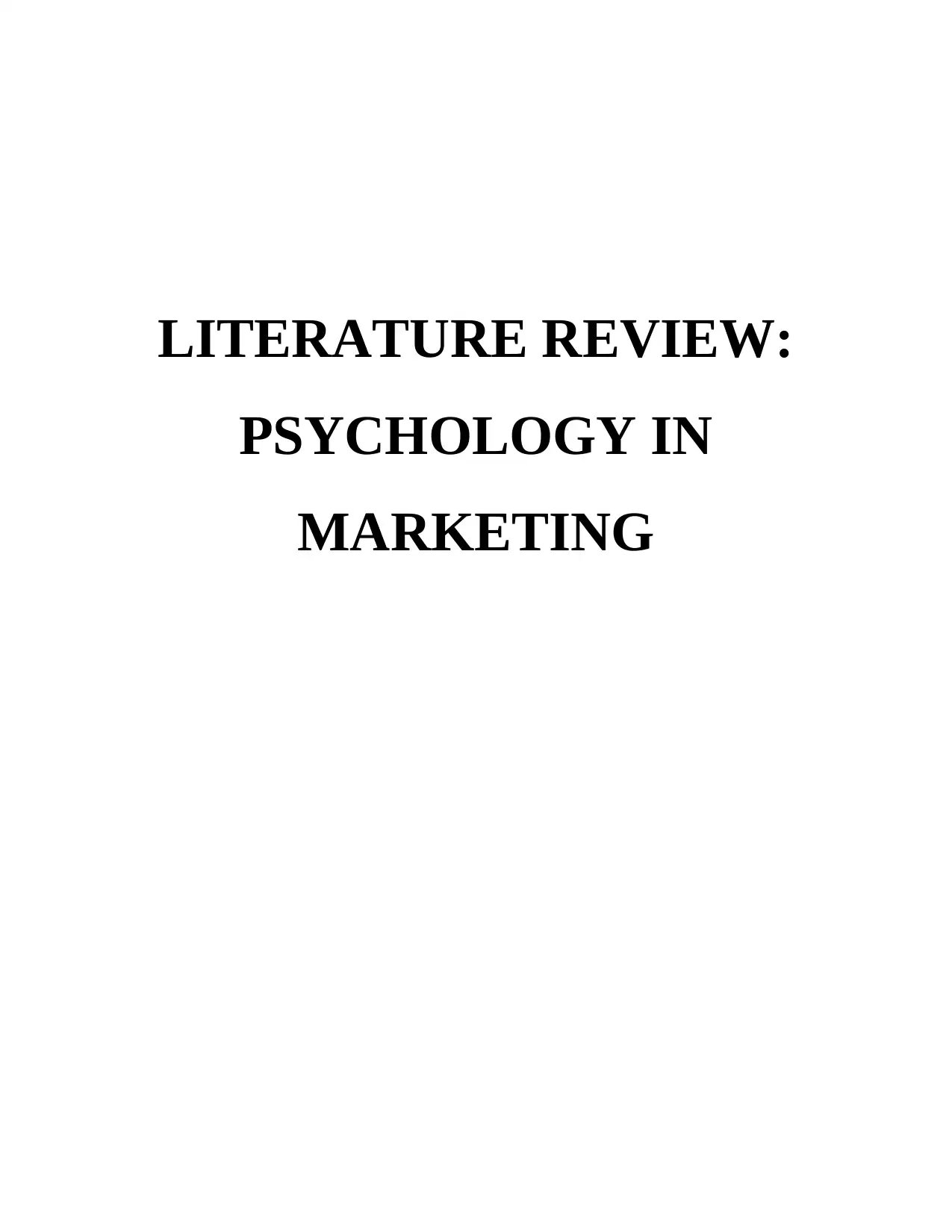
LITERATURE REVIEW:
PSYCHOLOGY IN
MARKETING
PSYCHOLOGY IN
MARKETING
Paraphrase This Document
Need a fresh take? Get an instant paraphrase of this document with our AI Paraphraser
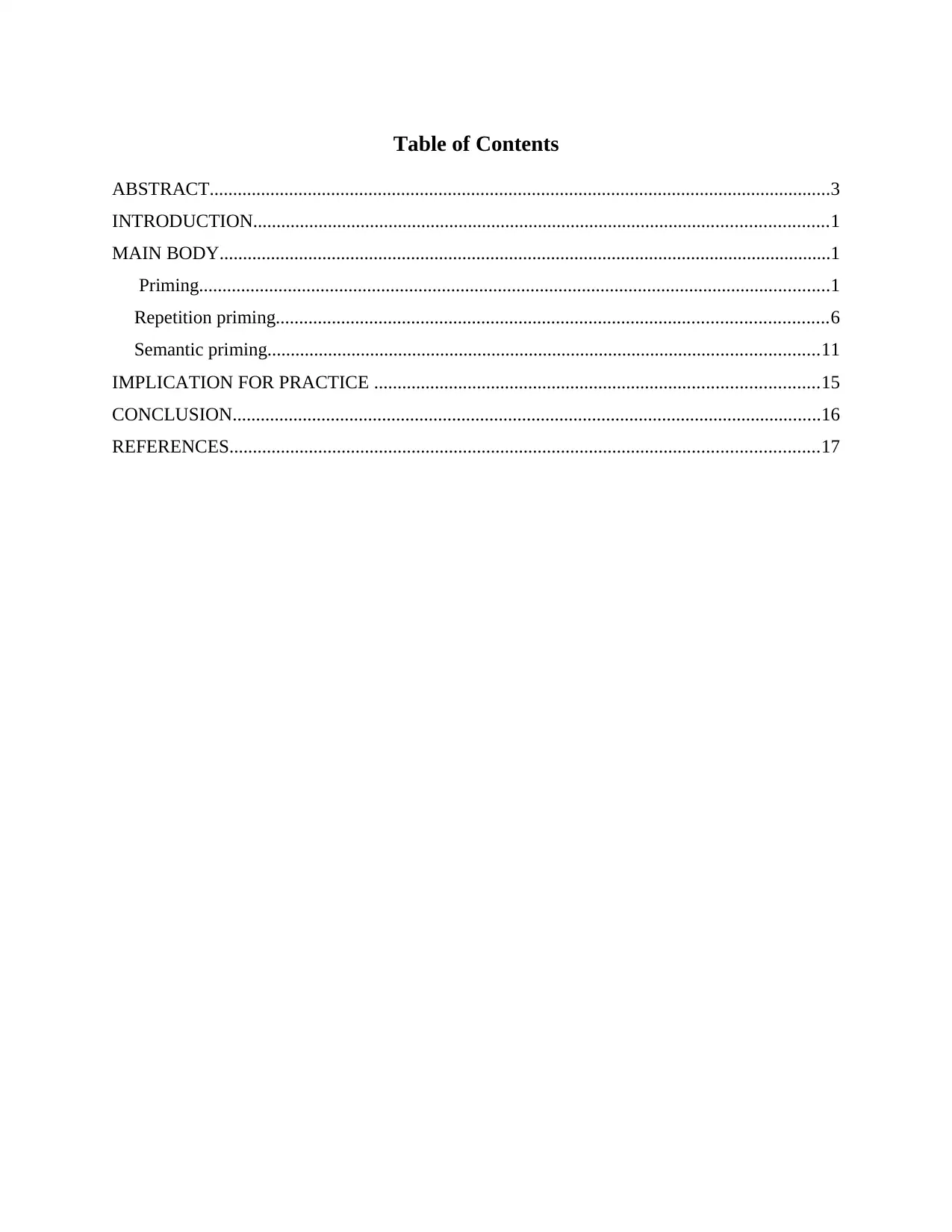
Table of Contents
ABSTRACT.....................................................................................................................................3
INTRODUCTION...........................................................................................................................1
MAIN BODY...................................................................................................................................1
Priming.......................................................................................................................................1
Repetition priming......................................................................................................................6
Semantic priming......................................................................................................................11
IMPLICATION FOR PRACTICE ...............................................................................................15
CONCLUSION..............................................................................................................................16
REFERENCES..............................................................................................................................17
ABSTRACT.....................................................................................................................................3
INTRODUCTION...........................................................................................................................1
MAIN BODY...................................................................................................................................1
Priming.......................................................................................................................................1
Repetition priming......................................................................................................................6
Semantic priming......................................................................................................................11
IMPLICATION FOR PRACTICE ...............................................................................................15
CONCLUSION..............................................................................................................................16
REFERENCES..............................................................................................................................17

⊘ This is a preview!⊘
Do you want full access?
Subscribe today to unlock all pages.

Trusted by 1+ million students worldwide
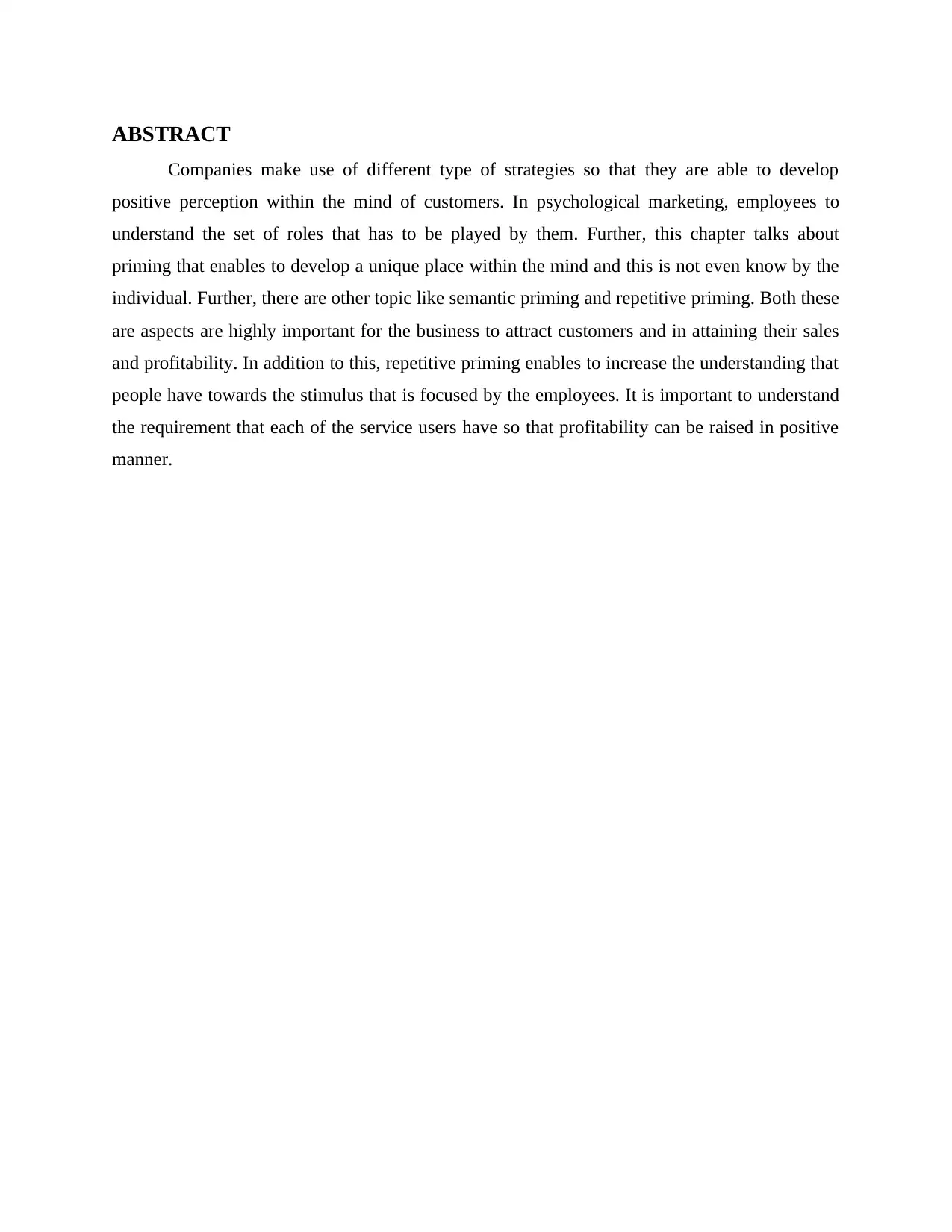
ABSTRACT
Companies make use of different type of strategies so that they are able to develop
positive perception within the mind of customers. In psychological marketing, employees to
understand the set of roles that has to be played by them. Further, this chapter talks about
priming that enables to develop a unique place within the mind and this is not even know by the
individual. Further, there are other topic like semantic priming and repetitive priming. Both these
are aspects are highly important for the business to attract customers and in attaining their sales
and profitability. In addition to this, repetitive priming enables to increase the understanding that
people have towards the stimulus that is focused by the employees. It is important to understand
the requirement that each of the service users have so that profitability can be raised in positive
manner.
Companies make use of different type of strategies so that they are able to develop
positive perception within the mind of customers. In psychological marketing, employees to
understand the set of roles that has to be played by them. Further, this chapter talks about
priming that enables to develop a unique place within the mind and this is not even know by the
individual. Further, there are other topic like semantic priming and repetitive priming. Both these
are aspects are highly important for the business to attract customers and in attaining their sales
and profitability. In addition to this, repetitive priming enables to increase the understanding that
people have towards the stimulus that is focused by the employees. It is important to understand
the requirement that each of the service users have so that profitability can be raised in positive
manner.
Paraphrase This Document
Need a fresh take? Get an instant paraphrase of this document with our AI Paraphraser
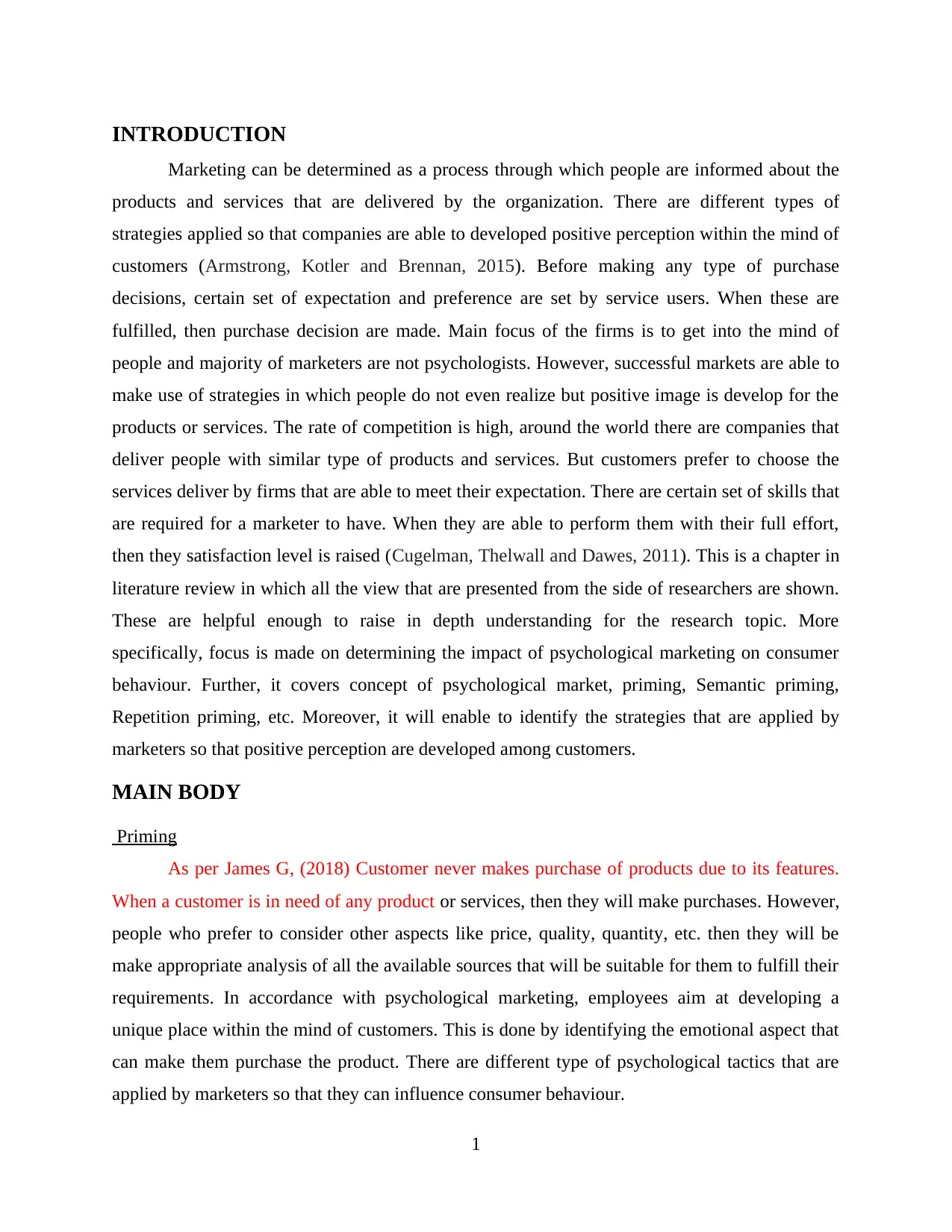
INTRODUCTION
Marketing can be determined as a process through which people are informed about the
products and services that are delivered by the organization. There are different types of
strategies applied so that companies are able to developed positive perception within the mind of
customers (Armstrong, Kotler and Brennan, 2015). Before making any type of purchase
decisions, certain set of expectation and preference are set by service users. When these are
fulfilled, then purchase decision are made. Main focus of the firms is to get into the mind of
people and majority of marketers are not psychologists. However, successful markets are able to
make use of strategies in which people do not even realize but positive image is develop for the
products or services. The rate of competition is high, around the world there are companies that
deliver people with similar type of products and services. But customers prefer to choose the
services deliver by firms that are able to meet their expectation. There are certain set of skills that
are required for a marketer to have. When they are able to perform them with their full effort,
then they satisfaction level is raised (Cugelman, Thelwall and Dawes, 2011). This is a chapter in
literature review in which all the view that are presented from the side of researchers are shown.
These are helpful enough to raise in depth understanding for the research topic. More
specifically, focus is made on determining the impact of psychological marketing on consumer
behaviour. Further, it covers concept of psychological market, priming, Semantic priming,
Repetition priming, etc. Moreover, it will enable to identify the strategies that are applied by
marketers so that positive perception are developed among customers.
MAIN BODY
Priming
As per James G, (2018) Customer never makes purchase of products due to its features.
When a customer is in need of any product or services, then they will make purchases. However,
people who prefer to consider other aspects like price, quality, quantity, etc. then they will be
make appropriate analysis of all the available sources that will be suitable for them to fulfill their
requirements. In accordance with psychological marketing, employees aim at developing a
unique place within the mind of customers. This is done by identifying the emotional aspect that
can make them purchase the product. There are different type of psychological tactics that are
applied by marketers so that they can influence consumer behaviour.
1
Marketing can be determined as a process through which people are informed about the
products and services that are delivered by the organization. There are different types of
strategies applied so that companies are able to developed positive perception within the mind of
customers (Armstrong, Kotler and Brennan, 2015). Before making any type of purchase
decisions, certain set of expectation and preference are set by service users. When these are
fulfilled, then purchase decision are made. Main focus of the firms is to get into the mind of
people and majority of marketers are not psychologists. However, successful markets are able to
make use of strategies in which people do not even realize but positive image is develop for the
products or services. The rate of competition is high, around the world there are companies that
deliver people with similar type of products and services. But customers prefer to choose the
services deliver by firms that are able to meet their expectation. There are certain set of skills that
are required for a marketer to have. When they are able to perform them with their full effort,
then they satisfaction level is raised (Cugelman, Thelwall and Dawes, 2011). This is a chapter in
literature review in which all the view that are presented from the side of researchers are shown.
These are helpful enough to raise in depth understanding for the research topic. More
specifically, focus is made on determining the impact of psychological marketing on consumer
behaviour. Further, it covers concept of psychological market, priming, Semantic priming,
Repetition priming, etc. Moreover, it will enable to identify the strategies that are applied by
marketers so that positive perception are developed among customers.
MAIN BODY
Priming
As per James G, (2018) Customer never makes purchase of products due to its features.
When a customer is in need of any product or services, then they will make purchases. However,
people who prefer to consider other aspects like price, quality, quantity, etc. then they will be
make appropriate analysis of all the available sources that will be suitable for them to fulfill their
requirements. In accordance with psychological marketing, employees aim at developing a
unique place within the mind of customers. This is done by identifying the emotional aspect that
can make them purchase the product. There are different type of psychological tactics that are
applied by marketers so that they can influence consumer behaviour.
1
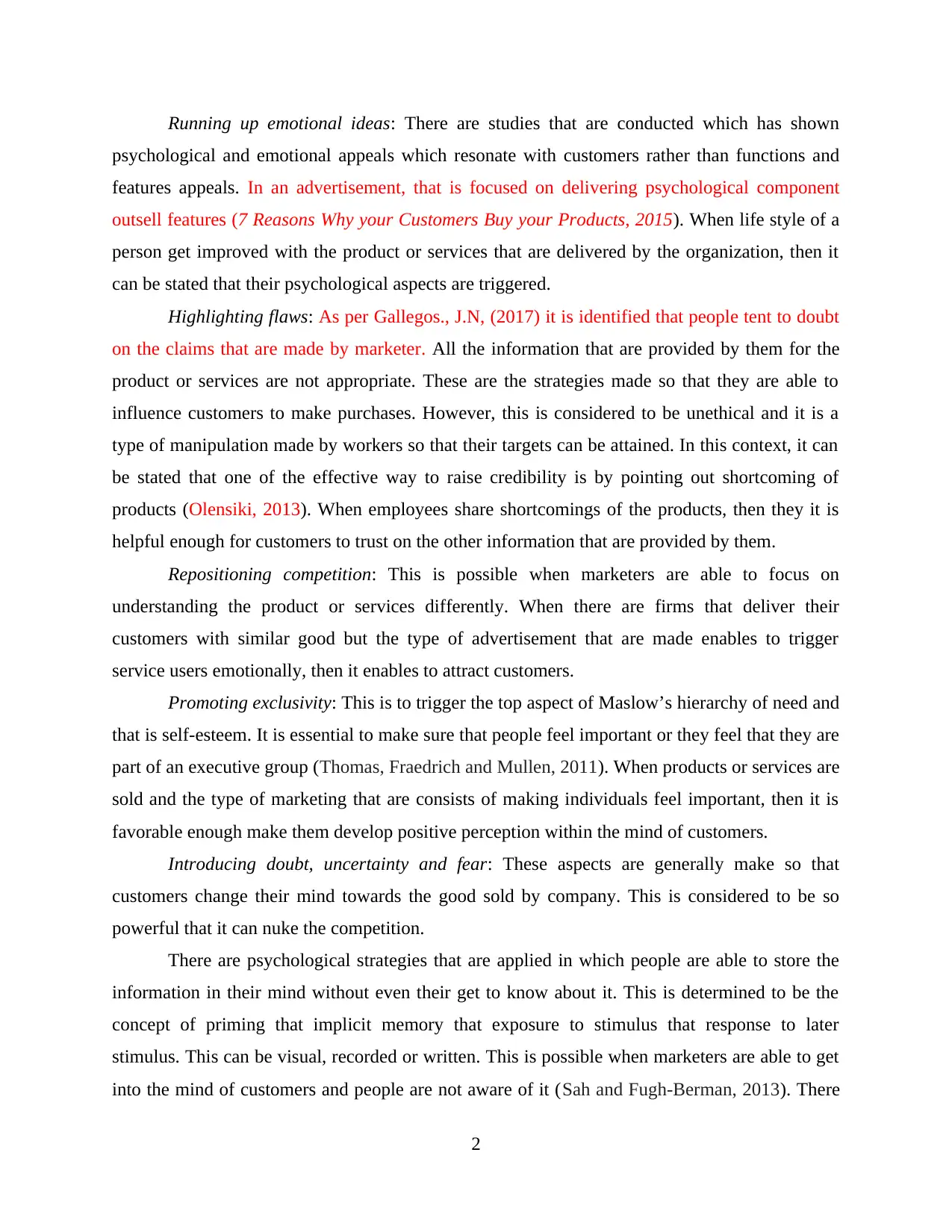
Running up emotional ideas: There are studies that are conducted which has shown
psychological and emotional appeals which resonate with customers rather than functions and
features appeals. In an advertisement, that is focused on delivering psychological component
outsell features (7 Reasons Why your Customers Buy your Products, 2015). When life style of a
person get improved with the product or services that are delivered by the organization, then it
can be stated that their psychological aspects are triggered.
Highlighting flaws: As per Gallegos., J.N, (2017) it is identified that people tent to doubt
on the claims that are made by marketer. All the information that are provided by them for the
product or services are not appropriate. These are the strategies made so that they are able to
influence customers to make purchases. However, this is considered to be unethical and it is a
type of manipulation made by workers so that their targets can be attained. In this context, it can
be stated that one of the effective way to raise credibility is by pointing out shortcoming of
products (Olensiki, 2013). When employees share shortcomings of the products, then they it is
helpful enough for customers to trust on the other information that are provided by them.
Repositioning competition: This is possible when marketers are able to focus on
understanding the product or services differently. When there are firms that deliver their
customers with similar good but the type of advertisement that are made enables to trigger
service users emotionally, then it enables to attract customers.
Promoting exclusivity: This is to trigger the top aspect of Maslow’s hierarchy of need and
that is self-esteem. It is essential to make sure that people feel important or they feel that they are
part of an executive group (Thomas, Fraedrich and Mullen, 2011). When products or services are
sold and the type of marketing that are consists of making individuals feel important, then it is
favorable enough make them develop positive perception within the mind of customers.
Introducing doubt, uncertainty and fear: These aspects are generally make so that
customers change their mind towards the good sold by company. This is considered to be so
powerful that it can nuke the competition.
There are psychological strategies that are applied in which people are able to store the
information in their mind without even their get to know about it. This is determined to be the
concept of priming that implicit memory that exposure to stimulus that response to later
stimulus. This can be visual, recorded or written. This is possible when marketers are able to get
into the mind of customers and people are not aware of it (Sah and Fugh‐Berman, 2013). There
2
psychological and emotional appeals which resonate with customers rather than functions and
features appeals. In an advertisement, that is focused on delivering psychological component
outsell features (7 Reasons Why your Customers Buy your Products, 2015). When life style of a
person get improved with the product or services that are delivered by the organization, then it
can be stated that their psychological aspects are triggered.
Highlighting flaws: As per Gallegos., J.N, (2017) it is identified that people tent to doubt
on the claims that are made by marketer. All the information that are provided by them for the
product or services are not appropriate. These are the strategies made so that they are able to
influence customers to make purchases. However, this is considered to be unethical and it is a
type of manipulation made by workers so that their targets can be attained. In this context, it can
be stated that one of the effective way to raise credibility is by pointing out shortcoming of
products (Olensiki, 2013). When employees share shortcomings of the products, then they it is
helpful enough for customers to trust on the other information that are provided by them.
Repositioning competition: This is possible when marketers are able to focus on
understanding the product or services differently. When there are firms that deliver their
customers with similar good but the type of advertisement that are made enables to trigger
service users emotionally, then it enables to attract customers.
Promoting exclusivity: This is to trigger the top aspect of Maslow’s hierarchy of need and
that is self-esteem. It is essential to make sure that people feel important or they feel that they are
part of an executive group (Thomas, Fraedrich and Mullen, 2011). When products or services are
sold and the type of marketing that are consists of making individuals feel important, then it is
favorable enough make them develop positive perception within the mind of customers.
Introducing doubt, uncertainty and fear: These aspects are generally make so that
customers change their mind towards the good sold by company. This is considered to be so
powerful that it can nuke the competition.
There are psychological strategies that are applied in which people are able to store the
information in their mind without even their get to know about it. This is determined to be the
concept of priming that implicit memory that exposure to stimulus that response to later
stimulus. This can be visual, recorded or written. This is possible when marketers are able to get
into the mind of customers and people are not aware of it (Sah and Fugh‐Berman, 2013). There
2
⊘ This is a preview!⊘
Do you want full access?
Subscribe today to unlock all pages.

Trusted by 1+ million students worldwide
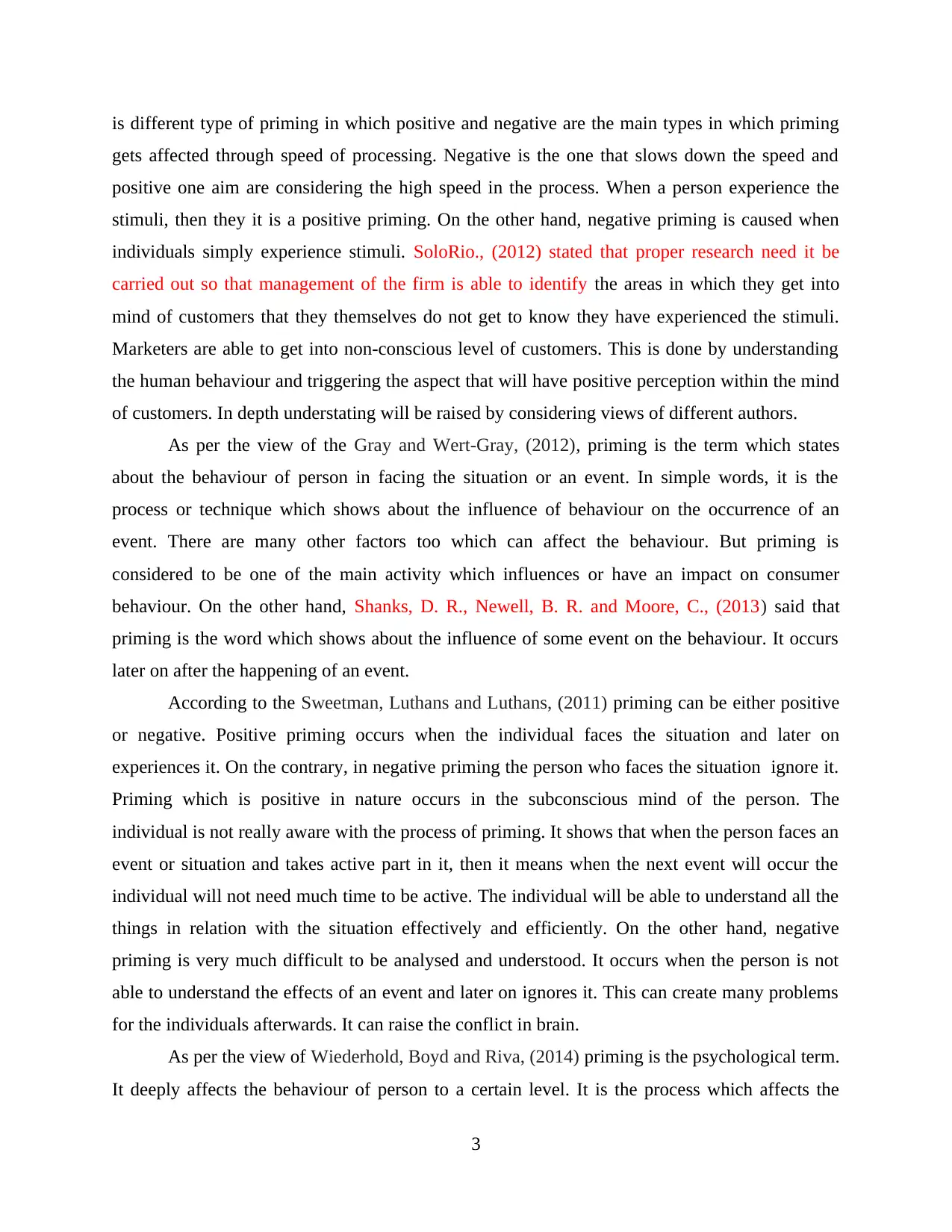
is different type of priming in which positive and negative are the main types in which priming
gets affected through speed of processing. Negative is the one that slows down the speed and
positive one aim are considering the high speed in the process. When a person experience the
stimuli, then they it is a positive priming. On the other hand, negative priming is caused when
individuals simply experience stimuli. SoloRio., (2012) stated that proper research need it be
carried out so that management of the firm is able to identify the areas in which they get into
mind of customers that they themselves do not get to know they have experienced the stimuli.
Marketers are able to get into non-conscious level of customers. This is done by understanding
the human behaviour and triggering the aspect that will have positive perception within the mind
of customers. In depth understating will be raised by considering views of different authors.
As per the view of the Gray and Wert‐Gray, (2012), priming is the term which states
about the behaviour of person in facing the situation or an event. In simple words, it is the
process or technique which shows about the influence of behaviour on the occurrence of an
event. There are many other factors too which can affect the behaviour. But priming is
considered to be one of the main activity which influences or have an impact on consumer
behaviour. On the other hand, Shanks, D. R., Newell, B. R. and Moore, C., (2013) said that
priming is the word which shows about the influence of some event on the behaviour. It occurs
later on after the happening of an event.
According to the Sweetman, Luthans and Luthans, (2011) priming can be either positive
or negative. Positive priming occurs when the individual faces the situation and later on
experiences it. On the contrary, in negative priming the person who faces the situation ignore it.
Priming which is positive in nature occurs in the subconscious mind of the person. The
individual is not really aware with the process of priming. It shows that when the person faces an
event or situation and takes active part in it, then it means when the next event will occur the
individual will not need much time to be active. The individual will be able to understand all the
things in relation with the situation effectively and efficiently. On the other hand, negative
priming is very much difficult to be analysed and understood. It occurs when the person is not
able to understand the effects of an event and later on ignores it. This can create many problems
for the individuals afterwards. It can raise the conflict in brain.
As per the view of Wiederhold, Boyd and Riva, (2014) priming is the psychological term.
It deeply affects the behaviour of person to a certain level. It is the process which affects the
3
gets affected through speed of processing. Negative is the one that slows down the speed and
positive one aim are considering the high speed in the process. When a person experience the
stimuli, then they it is a positive priming. On the other hand, negative priming is caused when
individuals simply experience stimuli. SoloRio., (2012) stated that proper research need it be
carried out so that management of the firm is able to identify the areas in which they get into
mind of customers that they themselves do not get to know they have experienced the stimuli.
Marketers are able to get into non-conscious level of customers. This is done by understanding
the human behaviour and triggering the aspect that will have positive perception within the mind
of customers. In depth understating will be raised by considering views of different authors.
As per the view of the Gray and Wert‐Gray, (2012), priming is the term which states
about the behaviour of person in facing the situation or an event. In simple words, it is the
process or technique which shows about the influence of behaviour on the occurrence of an
event. There are many other factors too which can affect the behaviour. But priming is
considered to be one of the main activity which influences or have an impact on consumer
behaviour. On the other hand, Shanks, D. R., Newell, B. R. and Moore, C., (2013) said that
priming is the word which shows about the influence of some event on the behaviour. It occurs
later on after the happening of an event.
According to the Sweetman, Luthans and Luthans, (2011) priming can be either positive
or negative. Positive priming occurs when the individual faces the situation and later on
experiences it. On the contrary, in negative priming the person who faces the situation ignore it.
Priming which is positive in nature occurs in the subconscious mind of the person. The
individual is not really aware with the process of priming. It shows that when the person faces an
event or situation and takes active part in it, then it means when the next event will occur the
individual will not need much time to be active. The individual will be able to understand all the
things in relation with the situation effectively and efficiently. On the other hand, negative
priming is very much difficult to be analysed and understood. It occurs when the person is not
able to understand the effects of an event and later on ignores it. This can create many problems
for the individuals afterwards. It can raise the conflict in brain.
As per the view of Wiederhold, Boyd and Riva, (2014) priming is the psychological term.
It deeply affects the behaviour of person to a certain level. It is the process which affects the
3
Paraphrase This Document
Need a fresh take? Get an instant paraphrase of this document with our AI Paraphraser
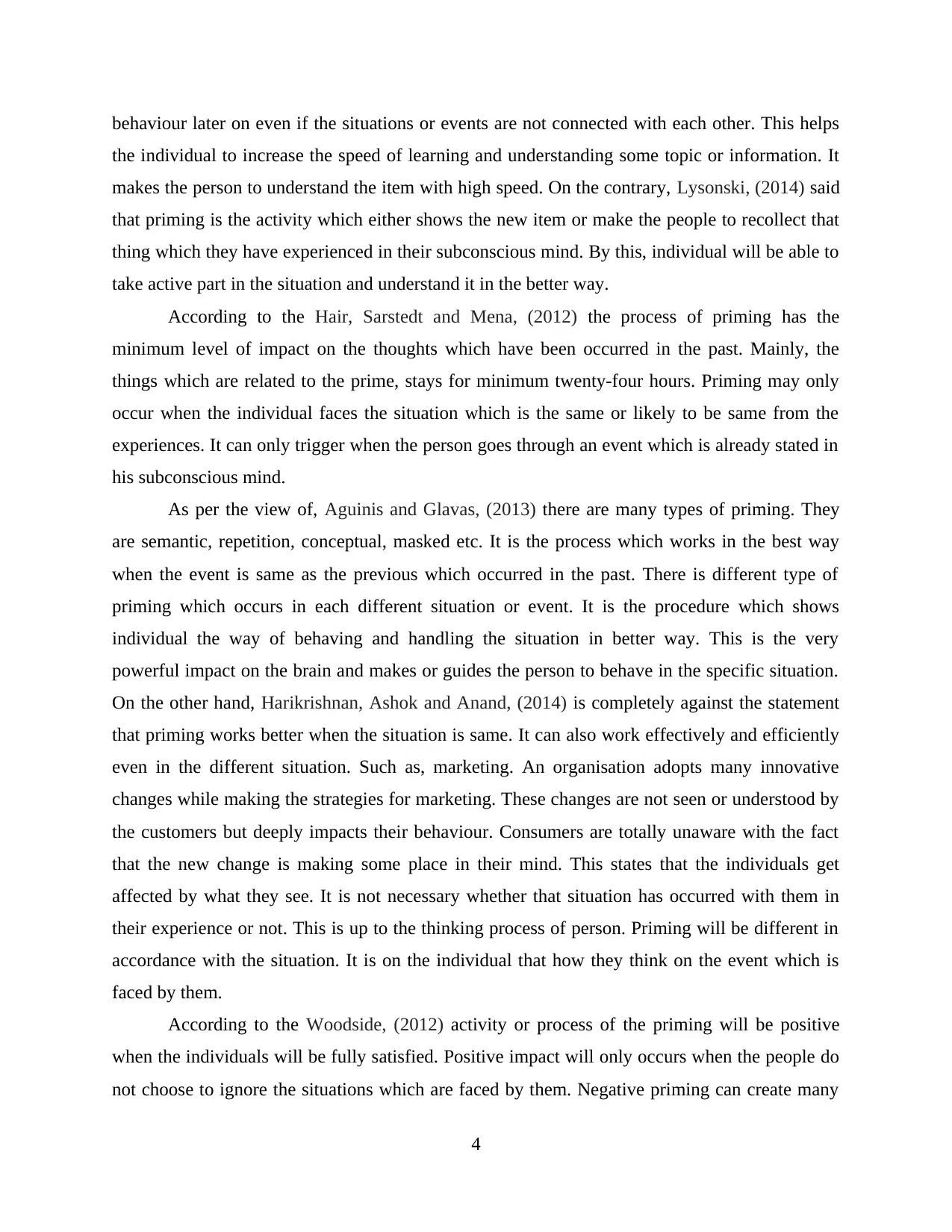
behaviour later on even if the situations or events are not connected with each other. This helps
the individual to increase the speed of learning and understanding some topic or information. It
makes the person to understand the item with high speed. On the contrary, Lysonski, (2014) said
that priming is the activity which either shows the new item or make the people to recollect that
thing which they have experienced in their subconscious mind. By this, individual will be able to
take active part in the situation and understand it in the better way.
According to the Hair, Sarstedt and Mena, (2012) the process of priming has the
minimum level of impact on the thoughts which have been occurred in the past. Mainly, the
things which are related to the prime, stays for minimum twenty-four hours. Priming may only
occur when the individual faces the situation which is the same or likely to be same from the
experiences. It can only trigger when the person goes through an event which is already stated in
his subconscious mind.
As per the view of, Aguinis and Glavas, (2013) there are many types of priming. They
are semantic, repetition, conceptual, masked etc. It is the process which works in the best way
when the event is same as the previous which occurred in the past. There is different type of
priming which occurs in each different situation or event. It is the procedure which shows
individual the way of behaving and handling the situation in better way. This is the very
powerful impact on the brain and makes or guides the person to behave in the specific situation.
On the other hand, Harikrishnan, Ashok and Anand, (2014) is completely against the statement
that priming works better when the situation is same. It can also work effectively and efficiently
even in the different situation. Such as, marketing. An organisation adopts many innovative
changes while making the strategies for marketing. These changes are not seen or understood by
the customers but deeply impacts their behaviour. Consumers are totally unaware with the fact
that the new change is making some place in their mind. This states that the individuals get
affected by what they see. It is not necessary whether that situation has occurred with them in
their experience or not. This is up to the thinking process of person. Priming will be different in
accordance with the situation. It is on the individual that how they think on the event which is
faced by them.
According to the Woodside, (2012) activity or process of the priming will be positive
when the individuals will be fully satisfied. Positive impact will only occurs when the people do
not choose to ignore the situations which are faced by them. Negative priming can create many
4
the individual to increase the speed of learning and understanding some topic or information. It
makes the person to understand the item with high speed. On the contrary, Lysonski, (2014) said
that priming is the activity which either shows the new item or make the people to recollect that
thing which they have experienced in their subconscious mind. By this, individual will be able to
take active part in the situation and understand it in the better way.
According to the Hair, Sarstedt and Mena, (2012) the process of priming has the
minimum level of impact on the thoughts which have been occurred in the past. Mainly, the
things which are related to the prime, stays for minimum twenty-four hours. Priming may only
occur when the individual faces the situation which is the same or likely to be same from the
experiences. It can only trigger when the person goes through an event which is already stated in
his subconscious mind.
As per the view of, Aguinis and Glavas, (2013) there are many types of priming. They
are semantic, repetition, conceptual, masked etc. It is the process which works in the best way
when the event is same as the previous which occurred in the past. There is different type of
priming which occurs in each different situation or event. It is the procedure which shows
individual the way of behaving and handling the situation in better way. This is the very
powerful impact on the brain and makes or guides the person to behave in the specific situation.
On the other hand, Harikrishnan, Ashok and Anand, (2014) is completely against the statement
that priming works better when the situation is same. It can also work effectively and efficiently
even in the different situation. Such as, marketing. An organisation adopts many innovative
changes while making the strategies for marketing. These changes are not seen or understood by
the customers but deeply impacts their behaviour. Consumers are totally unaware with the fact
that the new change is making some place in their mind. This states that the individuals get
affected by what they see. It is not necessary whether that situation has occurred with them in
their experience or not. This is up to the thinking process of person. Priming will be different in
accordance with the situation. It is on the individual that how they think on the event which is
faced by them.
According to the Woodside, (2012) activity or process of the priming will be positive
when the individuals will be fully satisfied. Positive impact will only occurs when the people do
not choose to ignore the situations which are faced by them. Negative priming can create many
4
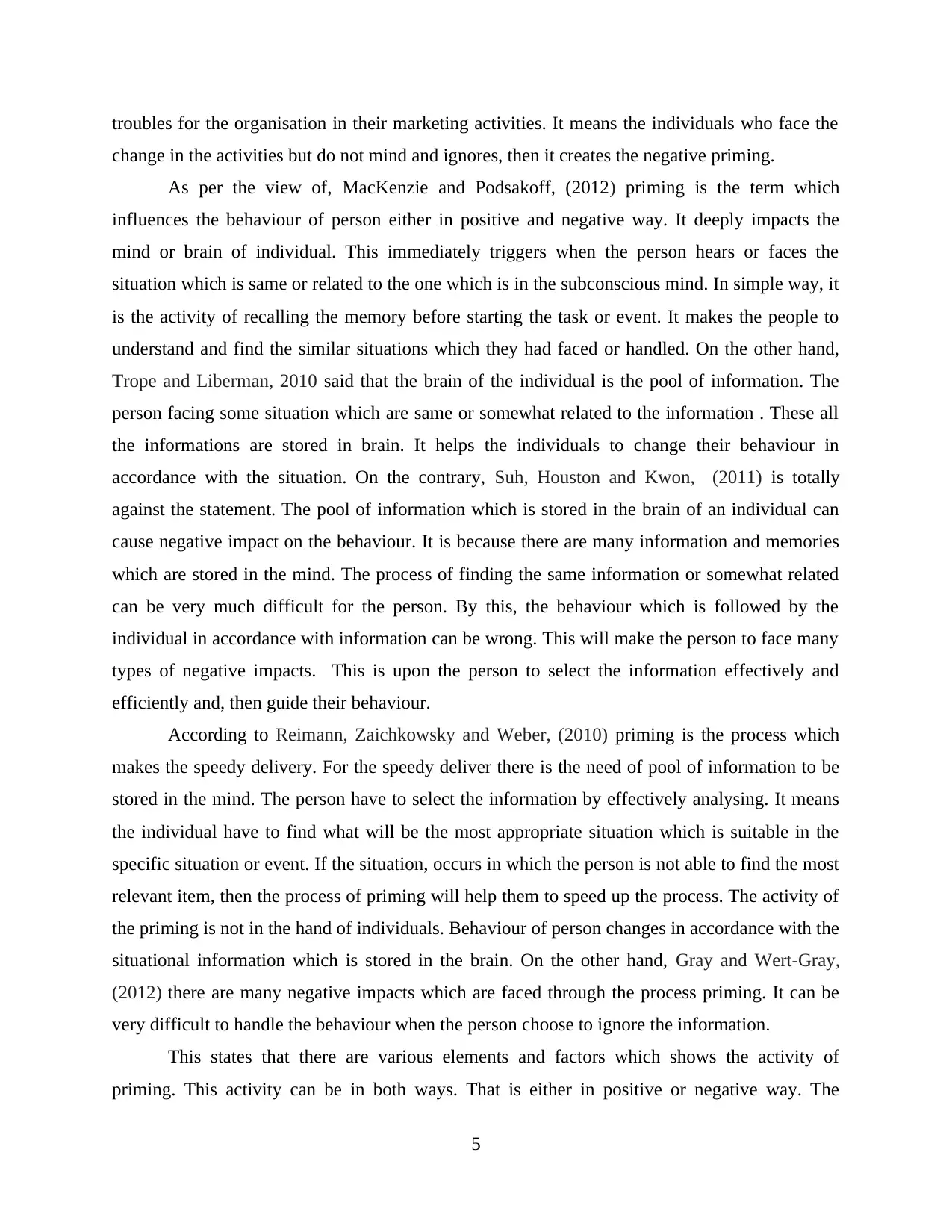
troubles for the organisation in their marketing activities. It means the individuals who face the
change in the activities but do not mind and ignores, then it creates the negative priming.
As per the view of, MacKenzie and Podsakoff, (2012) priming is the term which
influences the behaviour of person either in positive and negative way. It deeply impacts the
mind or brain of individual. This immediately triggers when the person hears or faces the
situation which is same or related to the one which is in the subconscious mind. In simple way, it
is the activity of recalling the memory before starting the task or event. It makes the people to
understand and find the similar situations which they had faced or handled. On the other hand,
Trope and Liberman, 2010 said that the brain of the individual is the pool of information. The
person facing some situation which are same or somewhat related to the information . These all
the informations are stored in brain. It helps the individuals to change their behaviour in
accordance with the situation. On the contrary, Suh, Houston and Kwon, (2011) is totally
against the statement. The pool of information which is stored in the brain of an individual can
cause negative impact on the behaviour. It is because there are many information and memories
which are stored in the mind. The process of finding the same information or somewhat related
can be very much difficult for the person. By this, the behaviour which is followed by the
individual in accordance with information can be wrong. This will make the person to face many
types of negative impacts. This is upon the person to select the information effectively and
efficiently and, then guide their behaviour.
According to Reimann, Zaichkowsky and Weber, (2010) priming is the process which
makes the speedy delivery. For the speedy deliver there is the need of pool of information to be
stored in the mind. The person have to select the information by effectively analysing. It means
the individual have to find what will be the most appropriate situation which is suitable in the
specific situation or event. If the situation, occurs in which the person is not able to find the most
relevant item, then the process of priming will help them to speed up the process. The activity of
the priming is not in the hand of individuals. Behaviour of person changes in accordance with the
situational information which is stored in the brain. On the other hand, Gray and Wert‐Gray,
(2012) there are many negative impacts which are faced through the process priming. It can be
very difficult to handle the behaviour when the person choose to ignore the information.
This states that there are various elements and factors which shows the activity of
priming. This activity can be in both ways. That is either in positive or negative way. The
5
change in the activities but do not mind and ignores, then it creates the negative priming.
As per the view of, MacKenzie and Podsakoff, (2012) priming is the term which
influences the behaviour of person either in positive and negative way. It deeply impacts the
mind or brain of individual. This immediately triggers when the person hears or faces the
situation which is same or related to the one which is in the subconscious mind. In simple way, it
is the activity of recalling the memory before starting the task or event. It makes the people to
understand and find the similar situations which they had faced or handled. On the other hand,
Trope and Liberman, 2010 said that the brain of the individual is the pool of information. The
person facing some situation which are same or somewhat related to the information . These all
the informations are stored in brain. It helps the individuals to change their behaviour in
accordance with the situation. On the contrary, Suh, Houston and Kwon, (2011) is totally
against the statement. The pool of information which is stored in the brain of an individual can
cause negative impact on the behaviour. It is because there are many information and memories
which are stored in the mind. The process of finding the same information or somewhat related
can be very much difficult for the person. By this, the behaviour which is followed by the
individual in accordance with information can be wrong. This will make the person to face many
types of negative impacts. This is upon the person to select the information effectively and
efficiently and, then guide their behaviour.
According to Reimann, Zaichkowsky and Weber, (2010) priming is the process which
makes the speedy delivery. For the speedy deliver there is the need of pool of information to be
stored in the mind. The person have to select the information by effectively analysing. It means
the individual have to find what will be the most appropriate situation which is suitable in the
specific situation or event. If the situation, occurs in which the person is not able to find the most
relevant item, then the process of priming will help them to speed up the process. The activity of
the priming is not in the hand of individuals. Behaviour of person changes in accordance with the
situational information which is stored in the brain. On the other hand, Gray and Wert‐Gray,
(2012) there are many negative impacts which are faced through the process priming. It can be
very difficult to handle the behaviour when the person choose to ignore the information.
This states that there are various elements and factors which shows the activity of
priming. This activity can be in both ways. That is either in positive or negative way. The
5
⊘ This is a preview!⊘
Do you want full access?
Subscribe today to unlock all pages.

Trusted by 1+ million students worldwide
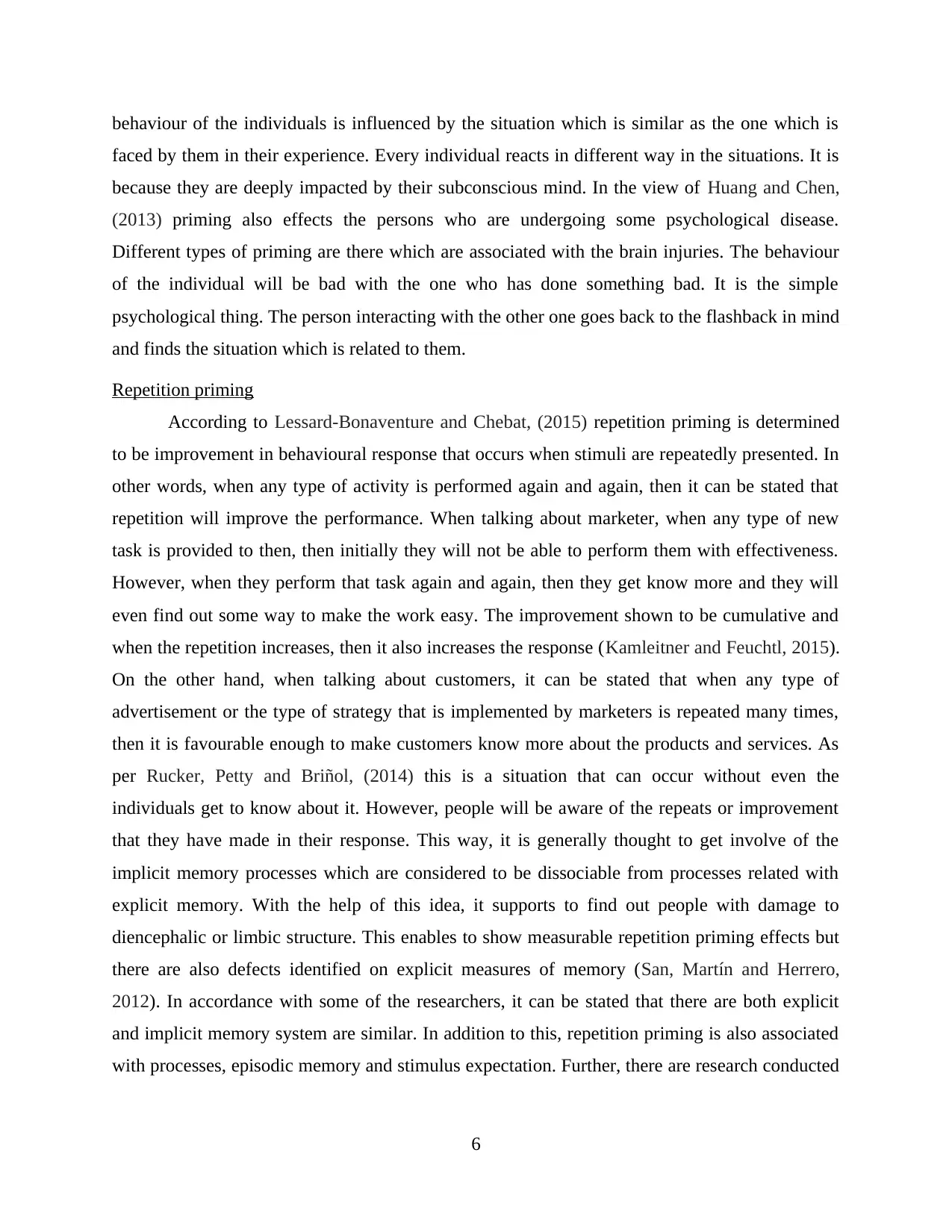
behaviour of the individuals is influenced by the situation which is similar as the one which is
faced by them in their experience. Every individual reacts in different way in the situations. It is
because they are deeply impacted by their subconscious mind. In the view of Huang and Chen,
(2013) priming also effects the persons who are undergoing some psychological disease.
Different types of priming are there which are associated with the brain injuries. The behaviour
of the individual will be bad with the one who has done something bad. It is the simple
psychological thing. The person interacting with the other one goes back to the flashback in mind
and finds the situation which is related to them.
Repetition priming
According to Lessard-Bonaventure and Chebat, (2015) repetition priming is determined
to be improvement in behavioural response that occurs when stimuli are repeatedly presented. In
other words, when any type of activity is performed again and again, then it can be stated that
repetition will improve the performance. When talking about marketer, when any type of new
task is provided to then, then initially they will not be able to perform them with effectiveness.
However, when they perform that task again and again, then they get know more and they will
even find out some way to make the work easy. The improvement shown to be cumulative and
when the repetition increases, then it also increases the response (Kamleitner and Feuchtl, 2015).
On the other hand, when talking about customers, it can be stated that when any type of
advertisement or the type of strategy that is implemented by marketers is repeated many times,
then it is favourable enough to make customers know more about the products and services. As
per Rucker, Petty and Briñol, (2014) this is a situation that can occur without even the
individuals get to know about it. However, people will be aware of the repeats or improvement
that they have made in their response. This way, it is generally thought to get involve of the
implicit memory processes which are considered to be dissociable from processes related with
explicit memory. With the help of this idea, it supports to find out people with damage to
diencephalic or limbic structure. This enables to show measurable repetition priming effects but
there are also defects identified on explicit measures of memory (San, Martín and Herrero,
2012). In accordance with some of the researchers, it can be stated that there are both explicit
and implicit memory system are similar. In addition to this, repetition priming is also associated
with processes, episodic memory and stimulus expectation. Further, there are research conducted
6
faced by them in their experience. Every individual reacts in different way in the situations. It is
because they are deeply impacted by their subconscious mind. In the view of Huang and Chen,
(2013) priming also effects the persons who are undergoing some psychological disease.
Different types of priming are there which are associated with the brain injuries. The behaviour
of the individual will be bad with the one who has done something bad. It is the simple
psychological thing. The person interacting with the other one goes back to the flashback in mind
and finds the situation which is related to them.
Repetition priming
According to Lessard-Bonaventure and Chebat, (2015) repetition priming is determined
to be improvement in behavioural response that occurs when stimuli are repeatedly presented. In
other words, when any type of activity is performed again and again, then it can be stated that
repetition will improve the performance. When talking about marketer, when any type of new
task is provided to then, then initially they will not be able to perform them with effectiveness.
However, when they perform that task again and again, then they get know more and they will
even find out some way to make the work easy. The improvement shown to be cumulative and
when the repetition increases, then it also increases the response (Kamleitner and Feuchtl, 2015).
On the other hand, when talking about customers, it can be stated that when any type of
advertisement or the type of strategy that is implemented by marketers is repeated many times,
then it is favourable enough to make customers know more about the products and services. As
per Rucker, Petty and Briñol, (2014) this is a situation that can occur without even the
individuals get to know about it. However, people will be aware of the repeats or improvement
that they have made in their response. This way, it is generally thought to get involve of the
implicit memory processes which are considered to be dissociable from processes related with
explicit memory. With the help of this idea, it supports to find out people with damage to
diencephalic or limbic structure. This enables to show measurable repetition priming effects but
there are also defects identified on explicit measures of memory (San, Martín and Herrero,
2012). In accordance with some of the researchers, it can be stated that there are both explicit
and implicit memory system are similar. In addition to this, repetition priming is also associated
with processes, episodic memory and stimulus expectation. Further, there are research conducted
6
Paraphrase This Document
Need a fresh take? Get an instant paraphrase of this document with our AI Paraphraser
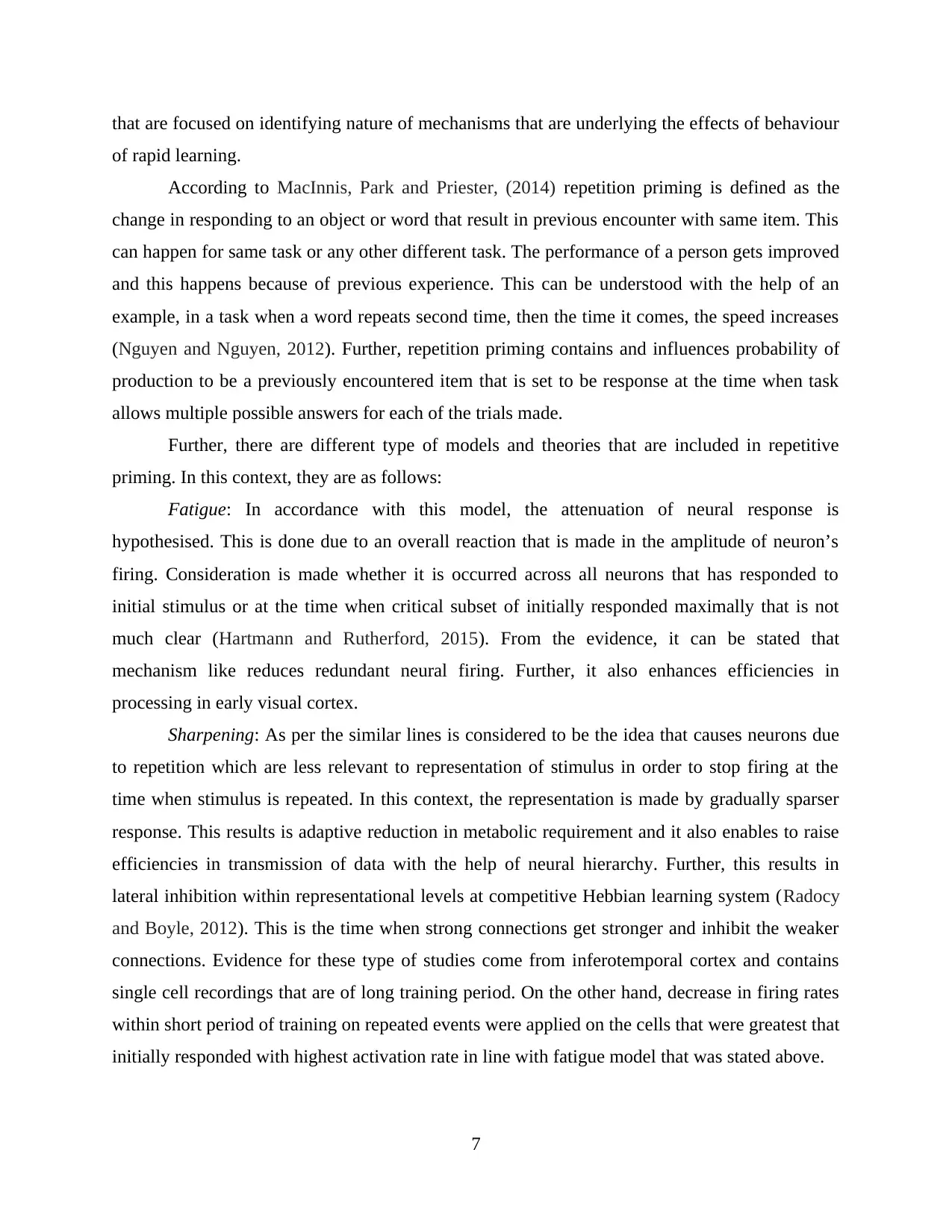
that are focused on identifying nature of mechanisms that are underlying the effects of behaviour
of rapid learning.
According to MacInnis, Park and Priester, (2014) repetition priming is defined as the
change in responding to an object or word that result in previous encounter with same item. This
can happen for same task or any other different task. The performance of a person gets improved
and this happens because of previous experience. This can be understood with the help of an
example, in a task when a word repeats second time, then the time it comes, the speed increases
(Nguyen and Nguyen, 2012). Further, repetition priming contains and influences probability of
production to be a previously encountered item that is set to be response at the time when task
allows multiple possible answers for each of the trials made.
Further, there are different type of models and theories that are included in repetitive
priming. In this context, they are as follows:
Fatigue: In accordance with this model, the attenuation of neural response is
hypothesised. This is done due to an overall reaction that is made in the amplitude of neuron’s
firing. Consideration is made whether it is occurred across all neurons that has responded to
initial stimulus or at the time when critical subset of initially responded maximally that is not
much clear (Hartmann and Rutherford, 2015). From the evidence, it can be stated that
mechanism like reduces redundant neural firing. Further, it also enhances efficiencies in
processing in early visual cortex.
Sharpening: As per the similar lines is considered to be the idea that causes neurons due
to repetition which are less relevant to representation of stimulus in order to stop firing at the
time when stimulus is repeated. In this context, the representation is made by gradually sparser
response. This results is adaptive reduction in metabolic requirement and it also enables to raise
efficiencies in transmission of data with the help of neural hierarchy. Further, this results in
lateral inhibition within representational levels at competitive Hebbian learning system (Radocy
and Boyle, 2012). This is the time when strong connections get stronger and inhibit the weaker
connections. Evidence for these type of studies come from inferotemporal cortex and contains
single cell recordings that are of long training period. On the other hand, decrease in firing rates
within short period of training on repeated events were applied on the cells that were greatest that
initially responded with highest activation rate in line with fatigue model that was stated above.
7
of rapid learning.
According to MacInnis, Park and Priester, (2014) repetition priming is defined as the
change in responding to an object or word that result in previous encounter with same item. This
can happen for same task or any other different task. The performance of a person gets improved
and this happens because of previous experience. This can be understood with the help of an
example, in a task when a word repeats second time, then the time it comes, the speed increases
(Nguyen and Nguyen, 2012). Further, repetition priming contains and influences probability of
production to be a previously encountered item that is set to be response at the time when task
allows multiple possible answers for each of the trials made.
Further, there are different type of models and theories that are included in repetitive
priming. In this context, they are as follows:
Fatigue: In accordance with this model, the attenuation of neural response is
hypothesised. This is done due to an overall reaction that is made in the amplitude of neuron’s
firing. Consideration is made whether it is occurred across all neurons that has responded to
initial stimulus or at the time when critical subset of initially responded maximally that is not
much clear (Hartmann and Rutherford, 2015). From the evidence, it can be stated that
mechanism like reduces redundant neural firing. Further, it also enhances efficiencies in
processing in early visual cortex.
Sharpening: As per the similar lines is considered to be the idea that causes neurons due
to repetition which are less relevant to representation of stimulus in order to stop firing at the
time when stimulus is repeated. In this context, the representation is made by gradually sparser
response. This results is adaptive reduction in metabolic requirement and it also enables to raise
efficiencies in transmission of data with the help of neural hierarchy. Further, this results in
lateral inhibition within representational levels at competitive Hebbian learning system (Radocy
and Boyle, 2012). This is the time when strong connections get stronger and inhibit the weaker
connections. Evidence for these type of studies come from inferotemporal cortex and contains
single cell recordings that are of long training period. On the other hand, decrease in firing rates
within short period of training on repeated events were applied on the cells that were greatest that
initially responded with highest activation rate in line with fatigue model that was stated above.
7
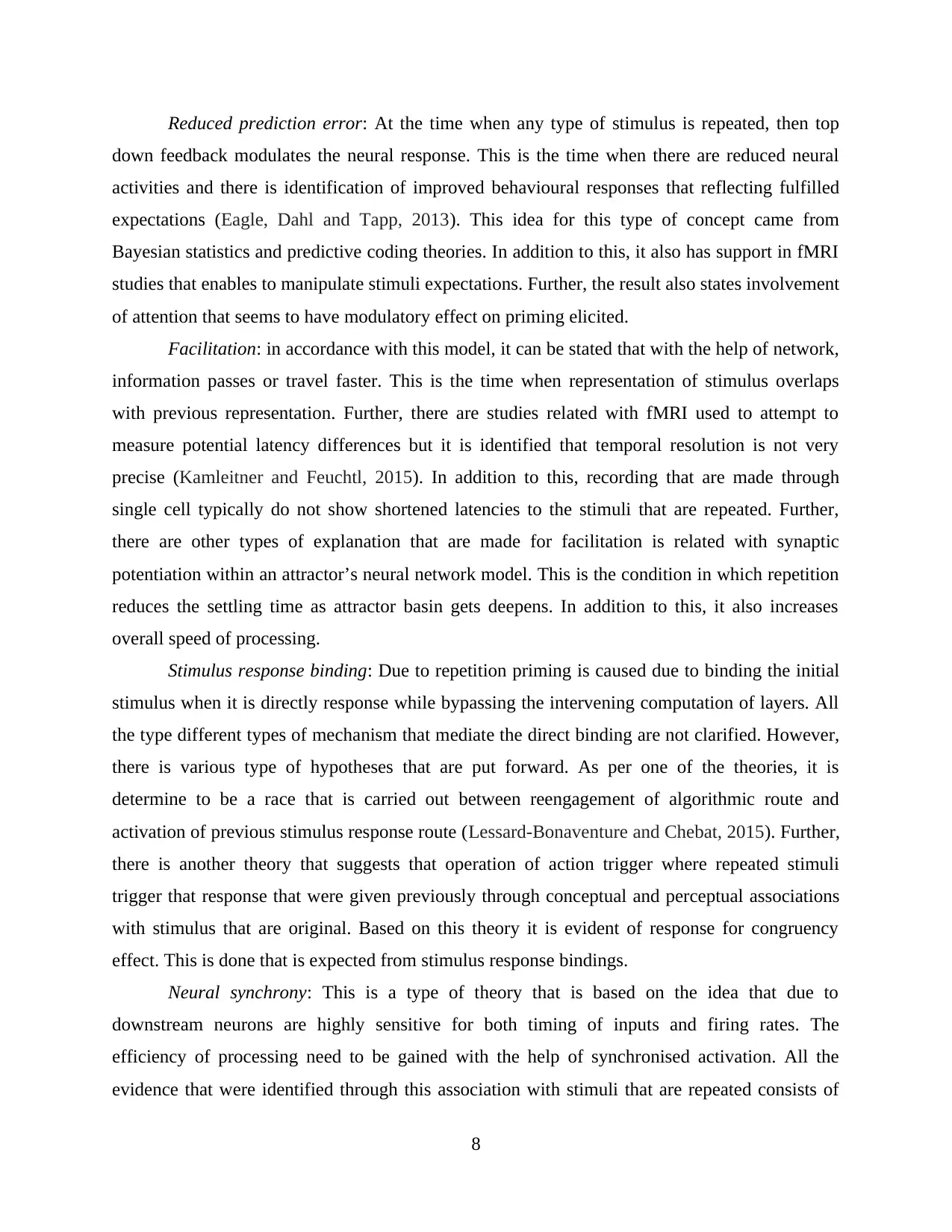
Reduced prediction error: At the time when any type of stimulus is repeated, then top
down feedback modulates the neural response. This is the time when there are reduced neural
activities and there is identification of improved behavioural responses that reflecting fulfilled
expectations (Eagle, Dahl and Tapp, 2013). This idea for this type of concept came from
Bayesian statistics and predictive coding theories. In addition to this, it also has support in fMRI
studies that enables to manipulate stimuli expectations. Further, the result also states involvement
of attention that seems to have modulatory effect on priming elicited.
Facilitation: in accordance with this model, it can be stated that with the help of network,
information passes or travel faster. This is the time when representation of stimulus overlaps
with previous representation. Further, there are studies related with fMRI used to attempt to
measure potential latency differences but it is identified that temporal resolution is not very
precise (Kamleitner and Feuchtl, 2015). In addition to this, recording that are made through
single cell typically do not show shortened latencies to the stimuli that are repeated. Further,
there are other types of explanation that are made for facilitation is related with synaptic
potentiation within an attractor’s neural network model. This is the condition in which repetition
reduces the settling time as attractor basin gets deepens. In addition to this, it also increases
overall speed of processing.
Stimulus response binding: Due to repetition priming is caused due to binding the initial
stimulus when it is directly response while bypassing the intervening computation of layers. All
the type different types of mechanism that mediate the direct binding are not clarified. However,
there is various type of hypotheses that are put forward. As per one of the theories, it is
determine to be a race that is carried out between reengagement of algorithmic route and
activation of previous stimulus response route (Lessard-Bonaventure and Chebat, 2015). Further,
there is another theory that suggests that operation of action trigger where repeated stimuli
trigger that response that were given previously through conceptual and perceptual associations
with stimulus that are original. Based on this theory it is evident of response for congruency
effect. This is done that is expected from stimulus response bindings.
Neural synchrony: This is a type of theory that is based on the idea that due to
downstream neurons are highly sensitive for both timing of inputs and firing rates. The
efficiency of processing need to be gained with the help of synchronised activation. All the
evidence that were identified through this association with stimuli that are repeated consists of
8
down feedback modulates the neural response. This is the time when there are reduced neural
activities and there is identification of improved behavioural responses that reflecting fulfilled
expectations (Eagle, Dahl and Tapp, 2013). This idea for this type of concept came from
Bayesian statistics and predictive coding theories. In addition to this, it also has support in fMRI
studies that enables to manipulate stimuli expectations. Further, the result also states involvement
of attention that seems to have modulatory effect on priming elicited.
Facilitation: in accordance with this model, it can be stated that with the help of network,
information passes or travel faster. This is the time when representation of stimulus overlaps
with previous representation. Further, there are studies related with fMRI used to attempt to
measure potential latency differences but it is identified that temporal resolution is not very
precise (Kamleitner and Feuchtl, 2015). In addition to this, recording that are made through
single cell typically do not show shortened latencies to the stimuli that are repeated. Further,
there are other types of explanation that are made for facilitation is related with synaptic
potentiation within an attractor’s neural network model. This is the condition in which repetition
reduces the settling time as attractor basin gets deepens. In addition to this, it also increases
overall speed of processing.
Stimulus response binding: Due to repetition priming is caused due to binding the initial
stimulus when it is directly response while bypassing the intervening computation of layers. All
the type different types of mechanism that mediate the direct binding are not clarified. However,
there is various type of hypotheses that are put forward. As per one of the theories, it is
determine to be a race that is carried out between reengagement of algorithmic route and
activation of previous stimulus response route (Lessard-Bonaventure and Chebat, 2015). Further,
there is another theory that suggests that operation of action trigger where repeated stimuli
trigger that response that were given previously through conceptual and perceptual associations
with stimulus that are original. Based on this theory it is evident of response for congruency
effect. This is done that is expected from stimulus response bindings.
Neural synchrony: This is a type of theory that is based on the idea that due to
downstream neurons are highly sensitive for both timing of inputs and firing rates. The
efficiency of processing need to be gained with the help of synchronised activation. All the
evidence that were identified through this association with stimuli that are repeated consists of
8
⊘ This is a preview!⊘
Do you want full access?
Subscribe today to unlock all pages.

Trusted by 1+ million students worldwide
1 out of 25
Related Documents
Your All-in-One AI-Powered Toolkit for Academic Success.
+13062052269
info@desklib.com
Available 24*7 on WhatsApp / Email
![[object Object]](/_next/static/media/star-bottom.7253800d.svg)
Unlock your academic potential
Copyright © 2020–2025 A2Z Services. All Rights Reserved. Developed and managed by ZUCOL.





